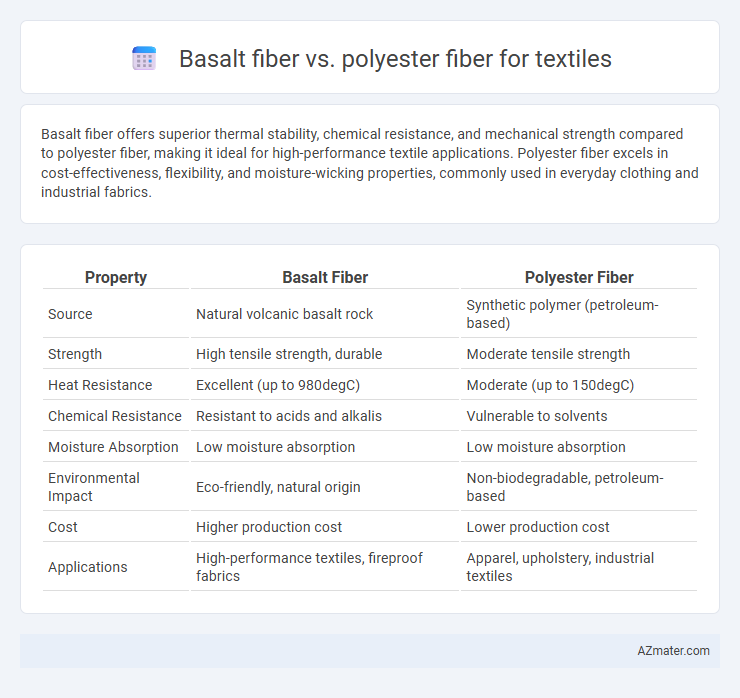Basalt fiber offers superior thermal stability, chemical resistance, and mechanical strength compared to polyester fiber, making it ideal for high-performance textile applications. Polyester fiber excels in cost-effectiveness, flexibility, and moisture-wicking properties, commonly used in everyday clothing and industrial fabrics.
Table of Comparison
| Property | Basalt Fiber | Polyester Fiber |
|---|---|---|
| Source | Natural volcanic basalt rock | Synthetic polymer (petroleum-based) |
| Strength | High tensile strength, durable | Moderate tensile strength |
| Heat Resistance | Excellent (up to 980degC) | Moderate (up to 150degC) |
| Chemical Resistance | Resistant to acids and alkalis | Vulnerable to solvents |
| Moisture Absorption | Low moisture absorption | Low moisture absorption |
| Environmental Impact | Eco-friendly, natural origin | Non-biodegradable, petroleum-based |
| Cost | Higher production cost | Lower production cost |
| Applications | High-performance textiles, fireproof fabrics | Apparel, upholstery, industrial textiles |
Introduction to Basalt Fiber and Polyester Fiber
Basalt fiber, derived from volcanic basalt rock, offers exceptional strength, thermal resistance, and environmental durability, making it an innovative alternative to traditional fibers in textile applications. Polyester fiber, a synthetic polymer made from petrochemical products, is widely valued for its affordability, light weight, and moisture-wicking properties in fabric production. Both fibers serve distinct roles in textiles, with basalt fiber providing enhanced mechanical performance and sustainability, while polyester remains popular for its versatility and cost-effectiveness.
Raw Materials and Production Processes
Basalt fiber is derived from natural volcanic basalt rocks melted at high temperatures around 1,400degC, while polyester fiber is synthesized from petrochemical products through polymerization of purified terephthalic acid and monoethylene glycol. The basalt fiber production involves melting, fiberizing, and cooling processes without chemical additives, resulting in eco-friendly and non-toxic fibers. Polyester fiber manufacturing uses a complex chemical and mechanical process including melt spinning, stretching, and crimping, which depends heavily on fossil fuel-based raw materials and energy-intensive refining.
Physical Properties Comparison
Basalt fiber exhibits a higher tensile strength of approximately 2750 MPa compared to polyester fiber's typical tensile strength of 350-700 MPa, making basalt fiber significantly stronger and more durable. Its density is around 2.7 g/cm3, closely matching polyester's lower density of 1.38 g/cm3 but providing superior thermal stability with a decomposition temperature above 700degC, whereas polyester fibers degrade near 260degC. Basalt fiber also offers enhanced UV and chemical resistance, ensuring better longevity in harsh environmental conditions compared to polyester fiber's moderate resistance levels.
Mechanical Strength and Durability
Basalt fiber exhibits significantly higher tensile strength and superior resistance to abrasion compared to polyester fiber, making it ideal for applications requiring enhanced mechanical strength in textiles. Its remarkable durability includes excellent resistance to high temperatures, chemical corrosion, and UV degradation, outperforming polyester in maintaining structural integrity over time. Polyester fiber, while flexible and lightweight, typically offers lower mechanical strength and is more susceptible to wear and environmental damage, reducing its longevity in demanding textile applications.
Fire Resistance and Thermal Stability
Basalt fiber offers significantly superior fire resistance compared to polyester fiber, with a higher ignition temperature exceeding 1000degC and no toxic gas emission during combustion. Polyester fiber melts and ignites at temperatures around 260degC, releasing harmful fumes and posing greater fire hazards. Basalt fiber's exceptional thermal stability maintains structural integrity at elevated temperatures, making it an ideal choice for flame-retardant textile applications over polyester fiber.
Environmental Impact and Sustainability
Basalt fiber, derived from natural volcanic rock, exhibits superior environmental sustainability compared to petroleum-based polyester fiber due to its low energy consumption during production and non-toxic, fully recyclable nature. Polyester fiber, while widely used for its durability and affordability, contributes significantly to microplastic pollution and relies heavily on fossil fuels, leading to higher carbon emissions and environmental degradation. The biodegradable properties of basalt fiber and its minimal ecological footprint position it as a more sustainable choice in textile manufacturing.
Cost Analysis and Economic Feasibility
Basalt fiber generally incurs higher initial costs compared to polyester fiber due to its raw material sourcing and manufacturing complexities, impacting upfront investment in textile production. Polyester fiber benefits from established large-scale production and raw material availability, resulting in lower unit costs and greater economic feasibility for mass-market textiles. Evaluating lifecycle costs, basalt fiber offers enhanced durability and thermal resistance, potentially reducing maintenance and replacement expenses in high-performance textile applications despite higher initial costs.
Applications in the Textile Industry
Basalt fiber offers superior thermal resistance, UV stability, and mechanical strength compared to polyester fiber, making it ideal for protective clothing, industrial textiles, and fireproof fabrics. Polyester fiber remains popular for its flexibility, cost-effectiveness, and moisture-wicking properties, extensively used in sportswear, home furnishings, and casual apparel. The choice between basalt and polyester fibers in textile applications depends on performance requirements, with basalt preferred in high-performance and harsh environment textiles and polyester dominating in everyday consumer products.
Market Trends and Future Prospects
Basalt fiber exhibits increasing demand in the textile market due to its superior thermal resistance, durability, and eco-friendly properties compared to polyester fiber, which dominates with cost-effectiveness and versatility. Market trends highlight a growing shift towards sustainable materials, boosting basalt fiber adoption in technical textiles, automotive, and construction sectors. Future prospects for basalt fiber indicate significant growth potential driven by innovations in manufacturing processes and rising environmental regulations favoring natural and recyclable fibers over synthetic polyester.
Conclusion: Choosing the Right Fiber for Textiles
Basalt fiber offers superior strength, heat resistance, and environmental sustainability compared to polyester fiber, making it ideal for high-performance textile applications. Polyester fiber remains popular due to its cost-effectiveness, versatility, and ease of processing in mass production. Selecting the right fiber depends on specific textile requirements such as durability, thermal properties, and budget constraints.

Infographic: Basalt fiber vs Polyester fiber for textile
 azmater.com
azmater.com